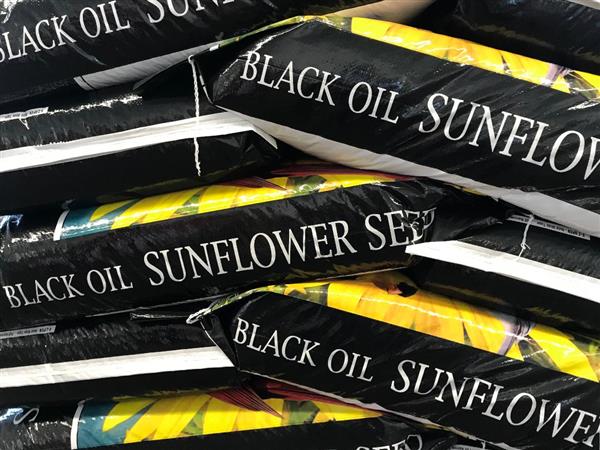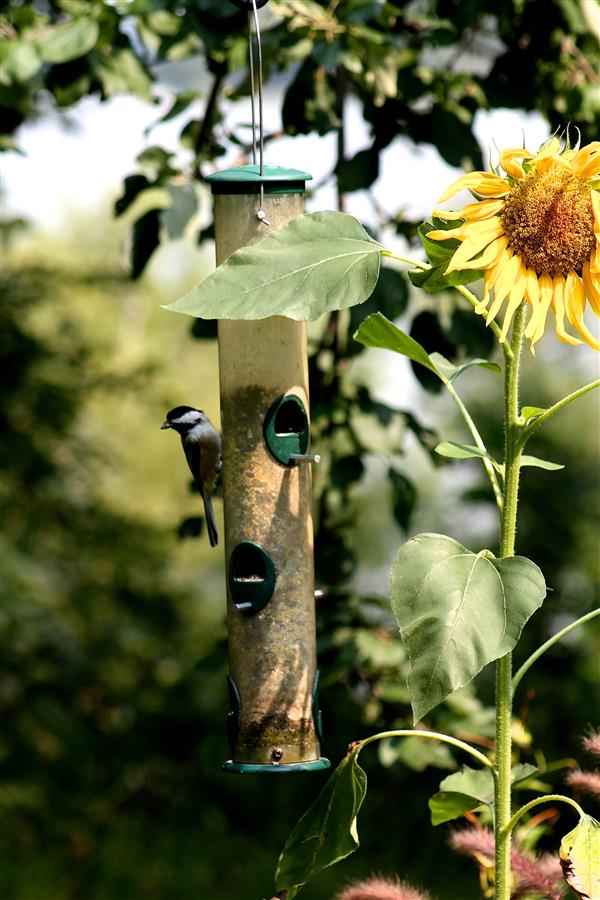Article Archives
For the Birds — In a Good Way
Friday, January 1, 2021
filed under: Utilization/Trade

Mention the word “birds” to many sunflower producers — especially those located in the Central Flyway Zone — and thoughts turn to flocks of marauding blackbirds preying on mature fields and, in the process, raising havoc with both seed yield and crop income.
Paradoxically, though, “birds” also contribute in a very substantial way to the overall value of each year’s sunflower crop. Sunflower’s role in the bird feeding industry is a major one. Black oil sunflower seeds are, in fact, the most-preferred ingredient by many bird species. Popular as well are sunflower chips and in-shell confection seeds (stripes).
A multi-year study titled Project Wildbird®, funded to the tune of $1 million by the Wild Bird Feeding Institute (WBFI) and its member companies, was completed in 2008. Its principal investigator, Dr. David Horn of Milliken University, Decatur, Ill., reported that each year more than 55 million Americans over the age of 16 fed wild birds or other wildlife around their homes — cumulatively spending more than $3.8 billion on bird seed, feeders and other accessories.
The WBFI study’s participants recorded nearly 1.3 million bird visits encompassing 106 bird species. When describing what species of birds visit their feeders, eight were listed at least 70% of the time: Mourning Dove (89%), Blue Jay (85%), American Goldfinch (82%), Black-capped Chickadee (79%), Downy Woodpecker (76%), Northern Cardinal (76%), House Finch (74%) and House Sparrow (74%).
Black oil sunflower seeds triggered the greatest number of bird visits overall, followed by fine and medium sunflower chips, Nyjer® and white proso millet. Likewise, black oil sunflower and sunflower chips attracted the greatest variety of bird species, Horn reported.
Those findings were not at all surprising to anyone involved in the wild bird feeding industry. In-shell oil sunflower has long ranked among the most popular of wild bird foods, with sunflower chips and confections (stripes) also very important parts of the equation. The biggest attraction of sunflower is its high energy value, stemming from its high oil content compared to most other seeds and nuts.
How valuable to the overall U.S. sunflower industry is the wild bird food sector?
Back in the spring of 1995, North Dakota State University published Agri- cultural Economics Report No. 327. Titled “Economic Contribution of the United States Sunflower Industry,” the 154-page report, authored by NDSU ag economists Dean Bangsund and F. Larry Leistritz alwith financial support from the National Sunflower Association, provided an unprecedented in-depth economic analysis of the nation’s sunflower industry. It broke down the data and discussion into four main segments: (1) sunflower crop production, (2) the sunflower oil industry, (3) the confection industry and (4) bird food activities.
All sunflower activities combined created $971 million in direct impacts, according to the NDSU study, which was based on the years 1991-93. Sunflower crop production, the sunflower oil industry, the confection sunflower industry and bird food activities together generated another $1.65 billion in secondary impact, for a total U.S. industry impact of $2.62 billion.
As to annual direct economic impact, the 1995 report placed the amount generated from sunflower production at $316.8 million; that of sunflower oil industry activities at $241.2 million; that of confection sunflower at $275.7 million — and, finally, the direct economic impact of the sunflower bird food sector at $137.3 million. So the bird food sector contributed more than 14% of the overall sunflower industry’s direct economic impact.
No similarly extensive studies have been conducted for the nation’s sunflower industry since that NDSU one a quarter century ago. However, there’s little doubt that sunflower’s value within the overall wild bird feeding industry has grown significantly since then in terms of volume, breadth of retail products and overall economic value.
 Some industry insiders estimate that about one-third (1/3) of the nation’s oil-type sunflower seed crop now ends up being purchased by the bird food sector. Using the average oil-type sunflower seed production total for the three-year period of 2017-19, that would translate into just over 600 million pounds annually. And, that volume does not include nonoil (confection) usage by the bird food industry.
Some industry insiders estimate that about one-third (1/3) of the nation’s oil-type sunflower seed crop now ends up being purchased by the bird food sector. Using the average oil-type sunflower seed production total for the three-year period of 2017-19, that would translate into just over 600 million pounds annually. And, that volume does not include nonoil (confection) usage by the bird food industry.
The overall bird food market has been relatively flat in recent years — until 2020. “While the population grew, the new entrants [into bird feeding] were offset by avid bird feeding baby boomers passing away and people flocking to live in the ‘cement jungle,’ ” says Wayne Lindberg, president of Sunbird, Inc., a longtime originator, conditioner and packager of wild bird feeding products. But with the proliferation of Covid-19 this past year, there was a “significant increase in feeding birds, as people were encouraged to stay home and social distance,” Lindberg explains.
“More people are working from home and have less options away from home,” affirms Paul Knudsen, grain merchandising manager for Seattle-based Global Harvest Foods. “They are spending money on home-based activities and goods that provide entertainment and give them a little joy in their day.”
The traditional profile of the average bird-feeding individual “was usually someone older, often retired,” Knudsen adds. “But we are seeing a shift, as more Gen-Xers and Millennials are working from home. They are looking for alternatives to ‘screen-based’ activities and are trying to find ways to connect with nature.”
As noted earlier, black oil sunflower sits atop the pyramid when it comes to bird preference and sales volume. Birds find it easy to shell and consume these seeds; plus, again, their high oil content translates into more energy.
It used to be almost a “given” that oil sunflower seeds with oil content below 40% would gravitate toward the bird food market. While that’s still common, some bird food companies offer a 2:1 premium, similar to the oilseed crushers, on oils above 40%.
D&D Commodities of Stephen, Minn., is one of them. D&D focuses on the “premium product” bird feed marketplace, versus the “open price point” market. Mike Wulf, the company’s president, says they sometimes pay a 2:1 premium on seeds above 40% oil in part because “the lighter the oils, the less seed we can get into a bag. We do a lot of smaller bags, and it all has to fit in boxes.” Also, consumers opting for premium products tend to be more committed to bird feeding and are willing to pay for higher-end products.
The premium product market utilizes more sunflower, safflower, nuts and fruits in its lines, Wulf notes, and less “filler,” e.g., millet, cracked corn, milo. Even prior to 2020, the premium product segment was seeing growth, he says. “Our (retail) customers are continuing to grow, continuing to add products. And it’s not just us; we’re seeing our competitors introduce high-price-point items with less filler in them.”
Curtis Kuntz, vice president-wildlife with Red River Commodities, Fargo, N.D., agrees that there’s more diversity than ever in the types and sizes of products available for bird-feeding consumers. “For example, you see more fruit, nuts — and even mealworms — infused into wild bird blends,” he says. “There is more-convenient packaging, smaller sizes and resealable bags. And, there’s more education focus provided on the packaging itself: what types of birds does this seed attract and what type of feeder should you use.”
For the more-casual bird-feeding individual, price is still the most influential factor driving purchasing behavior, Kuntz observes. “Having opening price-point options appeals to potential new users who are looking to explore this hobby, but are not [yet] interested in committing a significant spend,” he says. “Veteran feeders will look more closely at the quality of ingredients and opt for more premium grains to attract the more-colorful songbirds.”
“In the earlier years, retailers basically had a standard mix and a premium blend along with some [100%] sunflower,” adds Global Harvest Foods’ Knudsen. “Now, it’s not uncommon to see 30 to 40 different blends on the shelf.”
Premium product feeders also tend to feed birds on more of a year-round basis, compared to the more-casual, impulsive consumer. Winter months typically still see an uptick in bird food purchases — especially when there’s more snow on the ground. “Snowstorms always spur an increase in sales, because consumers are concerned about birds finding enough food to eat, and their natural food sources are harder to find,” Knudsen says.
But the seasonal fluctuations are less distinct for the premium products, according to D&D Commodities’ Mike Wulf. “While we do have peaks and valleys, we see a rise in business in the spring and early summer months,” he says. “Then, if there is a lot of available fruit — berries and natural food sources — in the late summer, we see a bit of decline because birds aren’t visiting the feeders as much.”
Despite Covid-19’s beneficial impact on wild bird food sales, no one, of course, wants the epidemic to drag on. Still, when it does draw toward an end, there likely will be a lingering effect on the bird food industry. “When the plague passes, I feel the industry will retain a number of the new consumers, resuming the growth relative to the population trend, encompassing a wider age bracket,” says Sunbird’s Wayne Lindberg, who is a former president of the Wild Bird Feeding Institute.
The increased interest generated by the at-home Covid lifestyle should extend at least partially beyond the time when the epidemic has been brought under control, agrees Red River Commodities’ Curtis Kuntz. Bird feeding at its essence “is a way to still feel connected with nature and to experience entertainment value in the comfort of one’s own backyard — and at a minimal cost,” he summarizes.
Regardless of future wild bird feeding trends, sunflower will retain its primary role within the industry. Be it the black oil seeds, the chips/kernels or the confection stripes, the appetite of many bird species for this premium ingredient will remain robust. That’s good economic news for the nation’s sunflower industry — and for its growers.
— Don Lilleboe